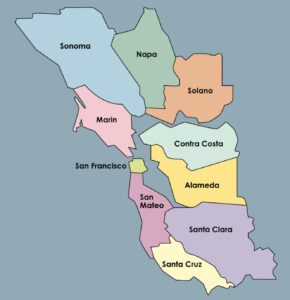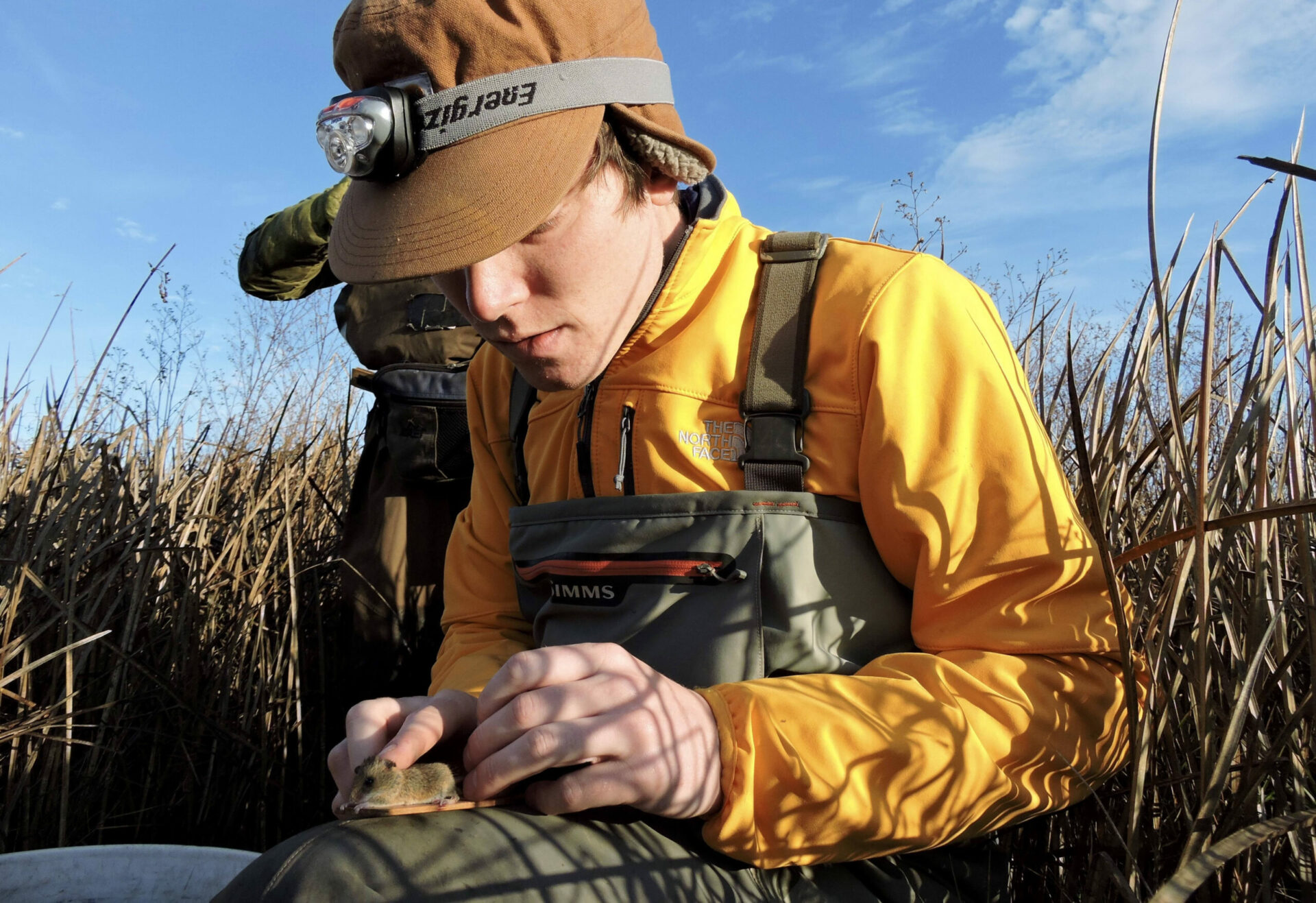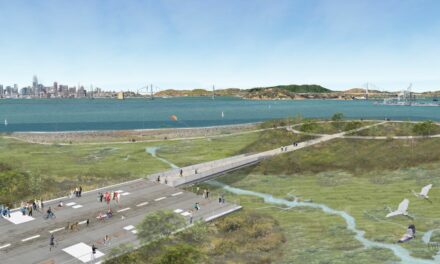Marsh Mice Come in Two Flavors
Endangered salt marsh harvest mouse climbing pickleweed. Photo: Cody Alyward
In the genes of a federally endangered mouse found only in the wetlands of the San Francisco Estuary, scientists have uncovered evidence of the waterway’s ancient expansions and contractions. Populations of the salt marsh harvest mouse have boomed and shrunk in synchrony with the reach of San Francisco Estuary’s tides, according to new research published in the journal Conservation Genetics.
The study, led by Cody Aylward and Mark Statham of the Mammalian Ecology and Conservation Unit at UC Davis, was spurred by a need to better characterize distinct populations within the species.
Researcher Cody Aylward in the field. Photo: UC Davis
For more than a century, scientists have asserted that the salt marsh harvest mouse (Reithrodontomys raviventris) comes in two flavors. Mice from the North Bay tend to have longer tails and pale belly fur, while those from the South Bay have shorter tails and reddish tummies.
“If we ever had to consider restocking or bolstering numbers of animals in any of these marshes, we would prefer to be able to take animals that are within the same subspecies,” Statham says.
The geographic dividing line between the two subspecies, however, was as muddy as the mouse’s environs. Mice from San Rafael, Corte Madera, Richmond, and Oakland wetlands resembled the southern subspecies, but some lived adjacent to populations with northern characteristics. This puzzled scientists.
“The Golden Gate seems like it would be this intuitive barrier to gene flow from the north and south. It didn’t make sense that populations north [of the Golden Gate] would belong to the southern subspecies,” says lead author Aylward, now with the World Wildlife Fund.
Seeking answers, the scientists analyzed whole mitochondrial genomes from 102 mice from across the range of the species. Most had been captured within the past 15 years. But for several Central Bay populations that are now extinct — those from Oakland and Marin — the scientists filled the gaps with museum specimens collected between 1930 and 1959.
Other Recent Posts
Artist Repurposes Shoreline Detritus
Courtney Griffith scours beaches and parks for everything from plastic to charcoal, mangled ropes and burnt wood to use in her work.
After The Fire: Scenes from Chinese Camp
One of California’s oldest Gold Rush settlements takes stock after a devastating fire — a photo essay.
Youth Group Tackles Heat Islands in Santa Rosa
A new youth advisory team convened by the Greenbelt Alliance and Latino Service Providers is exploring heat disparities in southwest Santa Rosa.
ReaderBoard
Once a month we share reader announcements: jobs, events, reports, and more.
CEQA Reforms: Boon or Brake for Adaptation?
California Environmental Quality Act updates may open up more housing, but some are sounding alarms about bypassed environmental regulations.
Repurposing Urban Lots & Waterfronts: Ashland Grove Park, Palo Alto Levee, and India Basin
In this edition of our professional column, we look at how groups are reimagining a lot in Ashland Grove and shorelines in San Francisco and Palo Alto.
Backyard Harvests Reduce Waste
A Cupertino Rotary Club program led by Vidula Aiyer harvests backyard fruit and reduces greenhouse gases.
Digging in the Dirt Got Me Into Student Climate Action
A public garden at El Cerrito High School in the East Bay inspired my love of nature and my decision to study environmental science at UCLA.
King Kong Levee: Two Miles Done, Two To Go
Two miles of levee are now in place as part of the project to protect Alviso and parts of San Jose, but construction will last much longer.
Making Shade a Priority in LA: An Interview with Sam Bloch
After witnessing fire disasters in neighboring counties, Marin formed a unique fire prevention authority and taxpayers funded it. Thirty projects and three years later, the county is clearer of undergrowth.
“What we found genetically is that north of the Golden Gate is the northern subspecies and south of the Golden Gate is the southern subspecies,” Aylward says — a finding which goes against current scientific understanding.
The data also enabled the researchers to track shifts in mouse demographics. “You can look backwards in time and see when the population was growing and when it was declining,” Aylward says.
The timing of those population shifts correlated beautifully with changes in the extent of the San Francisco Estuary, the researchers report. At the peak of the ice ages, the shoreline was west of today’s Farallon Islands. San Francisco Bay didn’t exist back then, and tidal marsh acreage was much smaller. Once the glaciers began to melt some 10,000 years ago, seawater began pouring through the Golden Gate to form the modern estuary. The marshes grew by leaps and bounds, enabling the mouse population to skyrocket apace.
The continued rise in water levels helps explain why some Central Bay mice look so different from their northern subspecies relatives. Mice in Marin and Corte Madera were likely cut off from adjacent populations as marshes were submerged and walled off by steep headlands.
Mouse climbing Grindelia. Photo: Cody Alyward
Mouse climbing Grindelia. Photo: Cody Alyward
The demographic data also revealed that the genetic diversity of “salties” (as they are fondly called by insiders) took a nosedive within the past few hundred years. This coincides with the 150-year period of diking, draining, and development that has decimated all but 10% of the San Francisco Estuary’s original tidal marshes.
“Our analysis confirmed that a lot of that genetic diversity loss is probably on us,” Statham says. “We [see] signs of how sea level rise has affected the evolutionary history of this species from way back all the way through to within our lifetime.”
For the mice of the urbanized central San Francisco Bay, climate change poses an existential threat. Roads and buildings now wall off marshes that can no longer relocate to higher ground. But the saga of the salties is far from over, Aylward says.
“As sea level rises, and less snowmelt comes out of the Sierra, the salinity gradient could move [upstream] into the Delta,” with tidal marsh not far behind. “That would be a natural opportunity for the mice to repeat their ancient pattern of expansion.”
More
- Surveying Salties to Save Them, Estuary News, October 2022
- Not so Picky Marsh Mouse, Estuary News, December 2019













